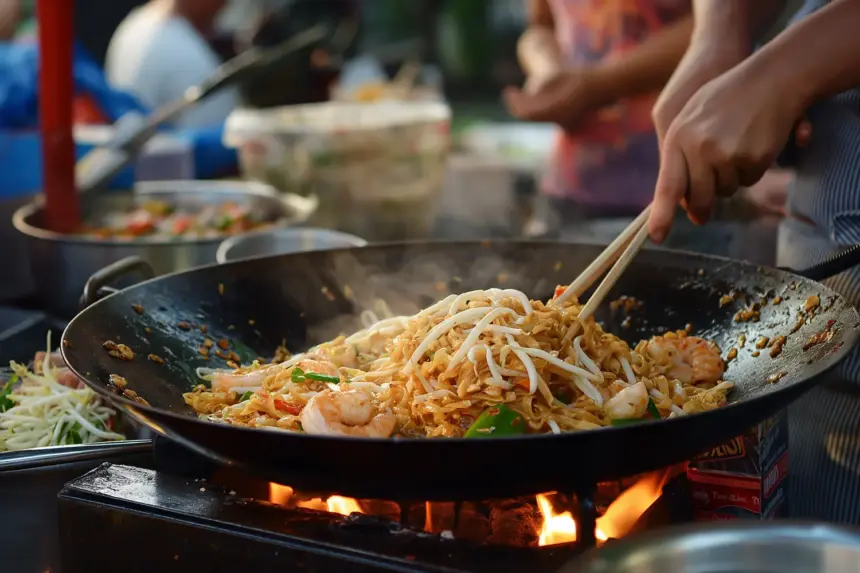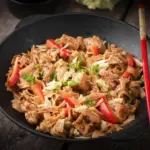Devour Thailand: The 10 Absolute Must-Try Street Foods That Will Blow Your Mind (A Friendly Foodie Guide)
Hey there, fellow food lovers and travel enthusiasts! Are you dreaming of vibrant streets, tantalizing aromas, and flavors that dance on your tongue? If Thailand is on your radar, then get ready, because we’re about to dive headfirst into a culinary adventure that defines the very soul of this incredible country: its street food scene!
- Devour Thailand: The 10 Absolute Must-Try Street Foods That Will Blow Your Mind (A Friendly Foodie Guide)
- 1. Pad Thai: The Reigning King of Thai Street Food
- 2. Mango Sticky Rice (Khao Niao Mamuang): The Sweet, Tropical Dream
- 3. Som Tum (Green Papaya Salad): The Spicy, Crunchy Wake-Up Call
- 4. Moo Ping / Gai Yang (Grilled Pork / Chicken Skewers): Smoky, Savory Perfection
- 5. Pad See Ew: The Comforting, Chewy Noodle Dish
- 6. Kuay Teow (Noodle Soup): A Bowl of Soulful Goodness
- 7. Pad Krapow Moo/Gai (Holy Basil Stir-fry): Fast, Furious, and Fragrant
- 8. Por Pia Tod (Fried Spring Rolls): The Crunchy, Golden Snack
- 9. Khanom Bueang (Crispy Pancakes / Thai Crepes): A Delicate Sweet Treat
- 10. Thai Iced Tea / Coffee (Cha Yen / Gafae Yen) & Fruit Shakes: The Essential Thirst Quenchers
- Beyond the Top 10: More Street Food Delights & Tips for Enjoying
- The Heartbeat of Thailand’s Culinary Scene
Forget fancy restaurants for a moment. While Thailand has its share of incredible fine dining, the real magic, the authentic flavors, the heart and soul of Thai cuisine, thrives on the bustling sidewalks, in the vibrant night markets, and alongside quiet sois (lanes). Thai street food isn’t just about eating; it’s an immersive cultural experience. It’s watching skilled vendors whip up culinary masterpieces right before your eyes, it’s the symphony of sizzling woks and chopping boards, it’s the friendly smiles, and the sheer joy of discovering incredible taste sensations for incredibly low prices.
From the chaotic energy of Bangkok’s Yaowarat (Chinatown) to the laid-back vibes of Chiang Mai’s walking streets and the coastal breezes of Phuket, street food is everywhere, and it’s uniformly delicious. It’s where locals eat, where families gather, and where curious travelers find their most memorable meals.
But with so many options, where do you even begin? Don’t worry, that’s where I come in! I’ve slurped noodles, devoured skewers, and sampled sweets across Thailand to bring you this guide to the absolute best 10 must-try Thai street foods. These are the iconic dishes that define the experience, the ones you absolutely cannot leave Thailand without trying. Get ready to get hungry!
Let’s dig in!
1. Pad Thai: The Reigning King of Thai Street Food
Okay, let’s start with the absolute classic, the dish that’s practically synonymous with Thai food around the world: Pad Thai. But forget the sometimes bland versions you might find elsewhere. Authentic Thai street-style Pad Thai is a revelation!
What is it? Pad Thai is a stir-fried rice noodle dish, typically cooked with eggs, tofu (or your choice of protein like shrimp or chicken), bean sprouts, and peanuts. The magic is in the sauce – a perfect balance of tamarind paste (for tanginess), fish sauce (for umami saltiness), palm sugar (for sweetness), and often chili flakes for a kick.
Why is it a must-try? It’s the perfect introduction to Thai flavors. It hits all the right notes: sweet, sour, salty, and often a touch spicy. Each vendor has their own secret twist, making every plate a unique experience. You’ll often find it served with fresh lime, extra peanuts, sugar, chili flakes, and banana blossoms on the side, allowing you to customize the flavor to your exact preference. Watching a skilled vendor work their wok magic, creating that perfect char on the noodles (the famous “wok hei”) is part of the show. It’s fast, it’s fresh, and it’s incredibly satisfying. You’ll find Pad Thai everywhere, from humble carts on street corners to bustling night markets. Look for vendors with a steady stream of customers – that’s usually a sign of a good Pad Thai!
2. Mango Sticky Rice (Khao Niao Mamuang): The Sweet, Tropical Dream
Moving from savory to sweet, we arrive at a dessert that is pure tropical bliss: Mango Sticky Rice, or Khao Niao Mamuang. This simple yet exquisite dish is an absolute sensation, especially when mangoes are in season (typically April to June, but often available year-round in tourist areas).
What is it? It’s exactly what it sounds like, but elevated to an art form. Perfectly ripe, sweet slices of mango are served alongside glutinous sticky rice that has been steamed and then mixed with rich, sweet coconut milk and a touch of sugar. It’s often topped with a drizzle of extra coconut cream and a sprinkle of toasted mung beans for a delightful crunch.
Why is it a must-try? The combination of the creamy, fragrant coconut milk-infused rice and the juicy, sweet mango is simply heavenly. It’s comforting, refreshing, and incredibly satisfying. It’s a perfect way to end a spicy meal or just enjoy as a mid-day treat. The best versions use the sweetest, most fragrant Nam Dok Mai or Ok Rong mango varieties. Finding a street vendor specializing in mango sticky rice, especially one where the rice is warm and the coconut sauce is rich, is a true treasure hunt with a delicious reward. It’s a taste of pure sunshine!
3. Som Tum (Green Papaya Salad): The Spicy, Crunchy Wake-Up Call
Ready for something bold, fresh, and potentially fiery? Then you need to try Som Tum, the iconic spicy green papaya salad from the Isaan region (Northeastern Thailand) that has conquered the entire country.
What is it? This salad is a vibrant mix of shredded green papaya, tomatoes, green beans, peanuts, dried shrimp, chilies, garlic, lime juice, fish sauce, and palm sugar, all pounded together using a mortar and pestle. This pounding technique is crucial as it releases the flavors and slightly bruises the ingredients.
Why is it a must-try? Som Tum is a symphony of textures and flavors: crunchy papaya, juicy tomatoes, nutty peanuts, and a dressing that is simultaneously spicy, sour, salty, and sweet. It’s incredibly refreshing, especially in the Thai heat, and pairs perfectly with grilled meats. Be warned: street vendors make it spicy! If you’re sensitive to heat, learn to say “Mai Pet” (not spicy) or “Pet Nit Noi” (a little spicy) and specify the number of chilies (e.g., “Sai prik Neung met” – put in one chili). There are many variations, including Som Tum Poo (with pickled crab) or Som Tum Pla Ra (with fermented fish sauce), which have stronger, more acquired tastes, but the classic Som Tum Thai is the best place to start.
4. Moo Ping / Gai Yang (Grilled Pork / Chicken Skewers): Smoky, Savory Perfection
As you walk the streets of Thailand, you’ll inevitably be drawn in by the irresistible aroma of meat grilling over charcoal. This is likely Moo Ping (grilled marinated pork skewers) or Gai Yang (grilled marinated chicken).
What is it? Slices of pork (Moo Ping) or chicken (Gai Yang) are marinated in a mixture that often includes soy sauce, oyster sauce, garlic, pepper, and palm sugar, then threaded onto bamboo skewers and grilled until tender, slightly charred, and wonderfully fragrant.
Why is it a must-try? These skewers are the ultimate street food snack or a perfect accompaniment to a plate of sticky rice (Khao Niao). The marinade creates a delicious sweet and savory glaze, and the grilling imparts a wonderful smoky flavor. Moo Ping, in particular, is often made with slightly fatty cuts of pork, which keeps it incredibly juicy and flavorful. They are readily available everywhere, cheap, and utterly addictive. Grab a few skewers for a quick bite while exploring, or make a meal out of them with sticky rice and a side of Som Tum!
5. Pad See Ew: The Comforting, Chewy Noodle Dish
While Pad Thai gets all the international fame, Pad See Ew is arguably a local favorite and a staple of the Thai street food scene. If you love noodles, this is a must-order.
What is it? This dish features wide, flat rice noodles stir-fried with Chinese broccoli (or sometimes regular broccoli), egg, and your choice of meat (often chicken, pork, or beef). The key flavor comes from dark soy sauce, which gives the noodles their characteristic dark color and a slightly sweet, savory, and complex flavor, often enhanced by the high heat of the wok creating a lovely smoky char.
Why is it a must-try? Pad See Ew is pure comfort food. The noodles are wonderfully chewy, the Chinese broccoli adds a nice bite, and the sauce is incredibly satisfying. It’s less tangy and sweet than Pad Thai, leaning more towards savory and slightly sweet notes. It’s less common to find extreme spice in Pad See Ew itself, though chili flakes are always available on the side. It’s a hearty, delicious, and widely available street food option that is incredibly popular with Thais. Look for vendors with giant woks – they are the masters of Pad See Ew!
6. Kuay Teow (Noodle Soup): A Bowl of Soulful Goodness
Noodle soups (Kuay Teow) are a cornerstone of Thai street food, offering endless variations of comforting, flavorful bowls perfect any time of day.
What is it? This is a broad category encompassing many different types of noodle soups. You choose your noodle type (rice noodles of various sizes, egg noodles, glass noodles), your broth (clear, dark soy sauce-based, spicy Tom Yum, or even thick, blood-enriched boat noodle broth), and your protein (pork, chicken, beef, fish balls, seafood). It’s typically garnished with bean sprouts, morning glory, and sometimes fried garlic or crispy wontons.
Why is it a must-try? Noodle soups are the ultimate customizable meal. You can find a bowl to suit any taste or mood. Kuay Teow Rua (Boat Noodles) are particularly famous – traditionally sold from boats, these smaller, rich, and slightly gamey bowls are often ordered in stacks. The magic of any Kuay Teow lies in the table condiments: sugar, fish sauce, chili flakes, and vinegar with chilies, allowing you to balance the flavors exactly how you like them. It’s a warm, comforting, and deeply flavorful experience that shows the versatility of Thai cooking. Don’t be afraid to try a few different types!
7. Pad Krapow Moo/Gai (Holy Basil Stir-fry): Fast, Furious, and Fragrant
If you want a quick, incredibly flavorful, and often spicy meal served over rice, look no further than Pad Krapow. This is one of the most popular lunch dishes for Thais, and street vendors nail it.
What is it? This dish is a quick stir-fry of minced meat (most commonly pork – Moo or chicken – Gai) with lots of garlic, fresh chilies, and the star ingredient: holy basil (krapow). Unlike sweet basil, holy basil has a distinct peppery, slightly anise-like flavor that is unmistakable. It’s seasoned with fish sauce, soy sauce, and a pinch of sugar. It’s almost always served hot over steamed white rice, and often topped with a fried egg (Kai Dao) with a delightfully runny yolk.
Why is it a must-try? Pad Krapow is an explosion of flavor in every bite. The heat from the chilies, the pungent garlic, and the unique aroma of the holy basil combine to create an incredibly addictive dish. It’s typically cooked very quickly in a hot wok, retaining the freshness of the ingredients. It’s the perfect example of how simple ingredients cooked expertly can create something truly memorable. Like Som Tum, be mindful of the spice level and order “Mai Pet” if needed, as vendors don’t hold back on the chilies unless you ask!
8. Por Pia Tod (Fried Spring Rolls): The Crunchy, Golden Snack
Sometimes, you just need a satisfying crunch and a flavorful bite on the go. That’s where Por Pia Tod, or Thai fried spring rolls, come in.
What is it? These are crispy, deep-fried rolls filled with a mixture that typically includes glass noodles, shredded cabbage, carrots, and sometimes minced pork or chicken. They are wrapped in thin pastry sheets and fried until golden brown and crispy. They are usually served with a sweet and tangy chili dipping sauce.
Why is it a must-try? They are the perfect portable snack. The contrast between the crispy exterior and the savory, tender filling is incredibly appealing. The dipping sauce adds a necessary burst of sweetness and acidity to cut through the richness of the fried roll. While you might find similar spring rolls elsewhere in Asia, the Thai version with its specific filling and ubiquitous sweet chili sauce is distinct and widely available from street vendors. Grab a bag and munch on them as you explore a market!
9. Khanom Bueang (Crispy Pancakes / Thai Crepes): A Delicate Sweet Treat
Ready for another sweet adventure? Khanom Bueang are delicate, crispy, taco-like crepes that are a popular traditional Thai snack.
What is it? These are made from a thin batter cooked on a hot griddle, creating a delicate, crispy shell. The shell is then filled with a dollop of sweet, fluffy coconut cream and typically topped with strands of sweetened egg yolk (foi thong) or sometimes savory toppings like dried shrimp and coriander (though the sweet version is more common for beginners!).
Why is it a must-try? Khanom Bueang offers a unique texture and a subtle, sweet flavor. The crispiness of the shell contrasts beautifully with the soft, creamy filling and the slightly chewy or crunchy topping. Watching the vendors make them is fascinating – they are cooked right in front of you on round griddles. They are small, inexpensive, and perfect for satisfying a sweet craving without being too heavy. Look for the stalls with the round griddles and stacks of these delicate treats!
10. Thai Iced Tea / Coffee (Cha Yen / Gafae Yen) & Fruit Shakes: The Essential Thirst Quenchers
Okay, while not strictly “food,” the drinks from street vendors are an absolutely essential part of the Thai street food experience and deserve a spot on this list. Hydration and refreshment are key!
What are they?
- Cha Yen (Thai Iced Tea): A strongly brewed black tea, sweetened with sugar and condensed milk, and often flavored with star anise or tamarind seed. It’s poured over ice, resulting in a creamy, sweet, and incredibly refreshing drink with its distinctive orange color.
- Gafae Yen (Thai Iced Coffee): Strong black coffee, sweetened with sugar and condensed milk, served over ice. Bold, sweet, and gives you a serious energy boost.
- Fruit Shakes (Lao Pan): Fresh fruits like mango, pineapple, watermelon, banana, or mixed fruits are blended with ice and sometimes a little sugar or condensed milk. Pure, cold, fruity goodness.
Why are they a must-try? These drinks are the perfect antidote to the Thai heat and the spice of the food. Cha Yen is iconic – its creamy sweetness is addictive. Gafae Yen is fantastic for coffee lovers. And the fruit shakes offer a healthy, refreshing burst of flavor. Street vendors make them fresh to order and they are incredibly affordable. Grabbing a bag or cup of one of these while you wander and eat is part of the quintessential Thai street food experience.
Beyond the Top 10: More Street Food Delights & Tips for Enjoying
This list is just the beginning! Thailand’s street food scene is incredibly diverse. As you explore, keep an eye out for:
- Gai Tod (Fried Chicken): Crispy and flavorful.
- Pla Pao (Salt-Crusted Grilled Fish): Often stuffed with lemongrass and herbs.
- Satay: Though similar to Moo Ping/Gai Yang, Thai satay often comes with a specific peanut dipping sauce and cucumber relish.
- Various Curries with Rice: Many street stalls offer pre-cooked curries (like Green Curry, Red Curry, Massaman Curry) served over rice.
- Hoy Tod (Oyster or Mussel Omelet): A crispy, starchy omelet cooked on a griddle.
- Thai Desserts: Beyond Mango Sticky Rice, there’s a huge variety of colorful and unique sweets.
Tips for a Safe and Delicious Street Food Adventure:
- Look for Crowds: Stalls with lots of customers, especially locals, are usually a good sign of fresh ingredients and delicious food. High turnover means ingredients aren’t sitting around.
- Watch the Prep: Observe how the food is handled. Does the vendor seem clean? Are they using gloves or utensils appropriately?
- Hygiene is Improving: Thai authorities have made great efforts to improve street food hygiene, especially in major tourist areas. Don’t be overly paranoid, but be mindful.
- Eat Where It’s Cooked Fresh: Dishes cooked to order in a wok right in front of you (like Pad Thai, Pad See Ew, Pad Krapow) are generally very safe due to the high cooking temperatures.
- Ask About Spice: Don’t be shy to say “Mai Pet” (not spicy) or ask for less chili (“Prik Nit Noi”). You can always add more heat from the condiments.
- Cash is King: Street food vendors primarily deal in cash. Have small denominations handy.
- Embrace the Experience: Eating on tiny plastic stools by the roadside is part of the fun! Soak in the atmosphere.
- Bring Wet Wipes/Hand Sanitizer: Useful for cleaning up before and after eating.
- Stay Hydrated: Grab a Thai Iced Tea, a fruit shake, or a bottle of water.
The Heartbeat of Thailand’s Culinary Scene
Thai street food is more than just fuel; it’s a cultural phenomenon, a way of life, and an unforgettable part of any trip to Thailand. It’s where you’ll find incredible flavors, meet friendly people, and experience the vibrant energy of the country. Each dish tells a story, passed down through generations of vendors perfecting their craft.
So, as you plan your Thai adventure, make sure you leave plenty of room in your itinerary (and your stomach!) for street food exploration. Be brave, be curious, and be ready to have your taste buds amazed. From the tangy Pad Thai to the sweet Mango Sticky Rice, the spicy Som Tum to the comforting noodle soups, these 10 dishes are just a starting point for a lifelong love affair with Thai cuisine.
Eating street food in Thailand is an accessible, affordable, and utterly delicious way to connect with the local culture and savor the authentic tastes of this incredible country. So go on, step out onto the street, follow the enticing aromas, and prepare to devour Thailand, one incredible bite at a time!
Enjoy your culinary journey!










